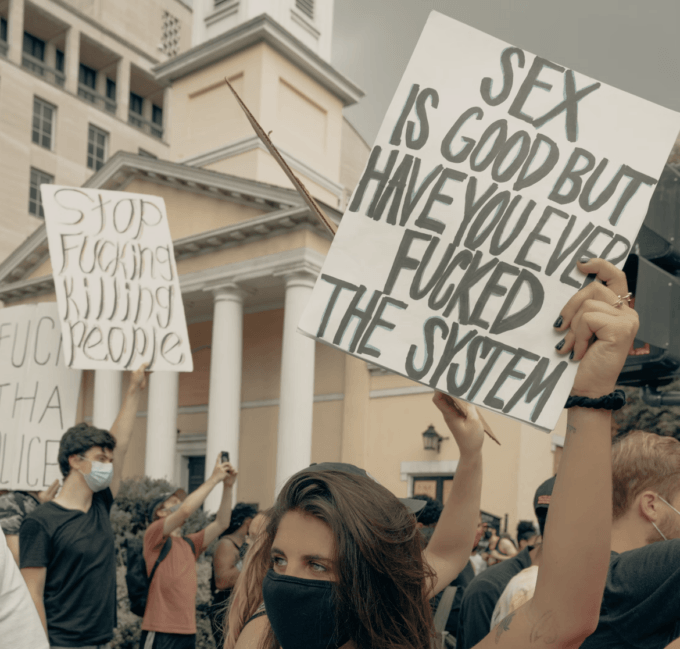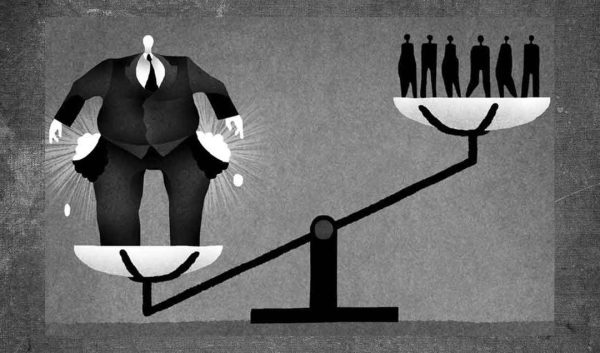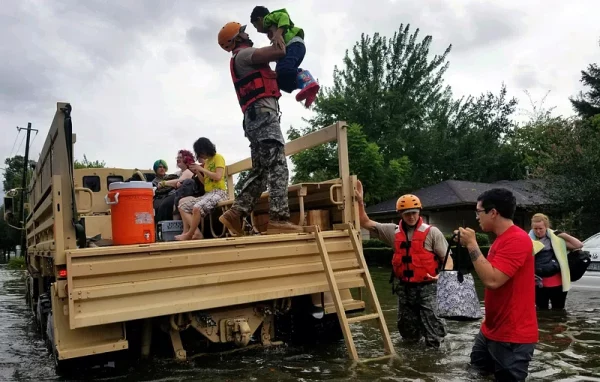
What if universities negotiated with students engaged in Gaza solidarity protests, instead of calling the police to violently arrest them? A mass movement opposing Israel’s ongoing assault on Gaza has spread like wildfire this Spring. Student organizers have issued demands ranging from university divestment from companies profiting from the war on Gaza and from Israel’s occupation of Palestine, to the creation of Palestinian studies programs, and more. In most cases, sadly, officials have responded with brute force, calling in police and destroying encampments. Republican House Speaker Mike Johnson called for the deployment of the National Guard, while New Jersey Democratic Congressman Josh Gottheimer wants to get the FBI involved, The Intercept reports. Thousands of students and faculty have been arrested so far this Spring, with several seriously injured.
“We set up for seven days,” Rafi Ash, a student at Brown University, said on the Democracy Now! news hour, describing Brown’s Gaza solidarity encampment. “Disciplinary threats…really did not sway students,”Rafi, part of Brown Jews for a Ceasefire Now, explained. “We were able to force them to the table on Monday of last week, and that led to a multi-day negotiation process…we were able to actually push to force a vote on divestment, that’s never happened before at Brown, something that we’ve been pushing for for a long time.”
For many Brown students, the war on Gaza hit home last Thanksgiving, when a white man shot Brown junior Hisham Awartani, along with his two close friends, all Palestinian Americans, while they were taking a walk near Hisham’s grandmother’s home in Burlington, Vermont. Hisham was paralyzed.
Students at Evergreen State College in Olympia, Washington, also successfully negotiated with their administration. The Evergreen community has its own painful connection to Gaza. Rachel Corrie was an Evergreen student in 2003 when she traveled to Rafah, in southern Gaza. Rachel was crushed to death by an Israeli military Caterpillar bulldozer on March 16th, 2003, while non-violently defending a Palestinian home from demolition.
Alex Marshall, a graduating Evergreen senior, explained on Democracy Now! how that history influenced negotiations:
“She’s been gone for 20 years, but her memory lives on amongst the student body… I’ve read her emails to her parents in multiple classes that I’ve taken at Evergreen.”
Through negotiations, Alex summarized, “we focused on divesting from companies that are profiting off of Israel’s occupation of Palestine…they also agreed to release a statement calling for a ceasefire and acknowledging the International Court of Justice’s genocide investigation.”
At Rutgers, New Jersey’s main public university, students also achieved a negotiated settlement.
“It was a four-day encampment. As a result of our collective efforts, we were able to have the Rutgers administration agree to commit to eight out of 10 demands,” Aseel, a Palestinian student at Rutgers-New Brunswick with family in Gaza, said on Democracy Now!, using only her first name for safety reasons.
“We demanded [Rutgers] divest from Israel, from Israeli apartheid and settler colonialism,” Aseel explained. “We did get an agreement to have a meeting with the Joint Committee on Investments, with the Board of Governors, with President Holloway, for divestment…we had been asking for a meeting for five years, and we finally got one.”
Calls for a ceasefire are mounting, pressuring the Biden administration. Sadly, any negotiated ceasefire will be too late for many Palestinians in Gaza, where the official death toll approaches 35,000.
“Nearly a hundred of my [family] members were martyred,” Aseel said. “I still have family left. I am still in contact with them. But they are all displaced. Our family home is basically destroyed…The Gaza that I once knew is essentially gone. But I am more than confident, along with my family, that we will return and that we will rebuild it.”
While many Jewish students have participated in the Gaza protests, mainstream media outlets focus on Jewish students who are opposed, saying the protests make them feel uncomfortable or threatened.
Frederick Lawrence, former president of Brandeis University, responded on Democracy Now!
“Many people feel that when they hear views that they deeply disagree with, that’s threatening to them. That’s not how universities operate. You are not entitled to be intellectually safe. You are entitled to be physically safe.” Brandeis was founded after World War II in the wake of the Holocaust, and named after Louis Brandeis, the first Jewish Supreme Court justice, known for his advocacy of free speech. Universities, Lawrence said, “exist for the purposes of creating and discovering knowledge.”.
Additional negotiated settlements have been announced at Pitzer College, University of California–Riverside, Sacramento State and Middlebury College. All these examples should be studied closely by university administrators, before they call in the police with their batons, rubber bullets, tear gas and handcuffs.
Campus activism for Palestinian liberation won’t be halted by university administrators’ lawless crackdowns.
By Maureen E. Ruprecht Fadem
Source: Truthout

USC Pro-Palestine encampement
The student encampment movement is expanding as faculty find new ways to intensify participation and solidarity. Teachers across the country are providing an example of how the wider community concerned about ending the assault on Gaza can do more than stand on the sidelines of today’s solidarity movement.
On May 8, faculty at The New School in New York City initiated the first faculty encampment. That action was taken as a rejoinder to the authoritarian overreach and sheer violence that has been unleashed on student protesters — at The New School, Columbia, City University of New York (CUNY), University of Texas Austin, New York University and numerous other campuses.
Participants in this first faculty encampment, and professors nationwide, are facing arrest along with their students, as they protest shoulder to shoulder with them and as they surround students, forming faculty shields, to protect them from police brutality.
The global betrayal of Palestine has emboldened the Israeli regime that is mass murdering and starving Gaza. Students across the globe have bravely answered the call of justice; they do what their silent-thus-complicit world and university leaders could not or simply did not do. University students have taken the leadership baton and are at the forefront worldwide demanding an end to the siege and to the brutalization of Palestine that has gone on far too long. And they are not backing down.
Starting on April 18 at Columbia University, college students came together in protest, an uprising that spread like wildfire, in a few days yielding more than 80 encampments in the U.S. A week later, on April 25, CUNY students joined the fray, setting up a smartly defined encampment at City College (CCNY). Its philosophical foundation was the set of five demands that hark back to a 1969 encampment at CCNY that similarly deployed a five-demand strategy.
These demonstrations of student leadership have been met with violent responses at many schools, including mine. On April 30, CCNY’s president invited New York Police Department (NYPD) officers in to demolish all the good work students had done; they roughed them up, arrested them and are apparently imposing disciplinary punishments. The NYPD broke their teeth, broke their bones and pepper-sprayed them. Some emerged needing hospitalization, and all were terrorized and traumatized. Still, students of CUNY and the world carry on, holding out in established encampments, commencing new ones on additional campuses, and, at CUNY, carrying on the fight. After criminalizing the students, criminalizing peaceful assembly, criminalizing free speech, criminalizing the language of justice and criminalizing the student demands, now the university misrepresents them in media coverage and institutional correspondence. In damage control mode, it claims the encampment posed a threat.
In lockstep with extremist Republicans and the legion of Democrats in political power, including the governor of New York and New York City’s law-and-order mayor, the university clamps down on students in a perfectly synchronized waltz with Fox News: Peaceful protestors are now “campus terrorists,” and the encampments are described not as antiwar or pro-Gaza but are instead inaccurately framed as “antisemitic.”
The final one-two punch? President Joe Biden broke his silence by condemning the wrong constituency, censuring not the violence of administrators and state agents but — perhaps following the lead of Israeli Prime Minister Benjamin Netanyahu — the unarmed civilians who were attacked, our students.
On the contrary, the student encampments have not posed “threats” to public safety — but university administrators are treating them as such because they are a threat to the continuation of a status quo in which U.S. institutions act in complicity with Israel’s ongoing slaughter of civilians in Gaza.
One of the criticisms that CCNY President Vincent Boudreau used to justify the dismantling of CUNY’s encampment was the claim that children were present. Some participants in the encampment brought their kids, and in fact there was an “arts corner” set up for them where they played. Far from a rationale to gut the encampment, isn’t it good for kids, in a society founded on democratic citizenship, to be exposed to free assembly in action? In other false justifications for the crackdowns, New York City Mayor Eric Adams has blamed everyone from “outside agitators” (referencing in one instance a woman who turned out to be a retired teacher who was inspired by the encampment and had stopped by) to faculty, whom he accuses of “radically indoctrinating” students (a claim Fox News wasted no time capitalizing on). As The Nation has reported, Adams claims there is “a movement to radicalize young people … a global problem” in which “young people are being influenced” by individuals he calls “professionals,” which includes faculty. For some time, the right has accused college faculty of not being teachers but indoctrinators. It is an absurd position, one perfectly aligned with MAGA’s gag order phenomenon, anti-knowledge “value” system and ongoing assault on humanities education.
What we’re seeing today is a clear rift among university leadership between authoritarian-style administrators and those who are either simply respecting the right to free assembly and expression, as at Harvard, or who are entering into genuine negotiations with students on their political justice demands. We’ve seen good work in this regard at Pomona College, Rutgers, University of Minnesota, University of California Riverside and Evergreen State College, among others. Though these negotiations do raise concerns about student demands getting whitewashed or watered down, still, where democratic process has been engaged rather than militant crackdowns students appear energized and hopeful.
This university leadership schism posed was illustrated in a nine-hour “discrepancy” at CUNY: NYPD entered and cleared the CCNY encampment, started beating up and arresting students and faculty, nine hours before the end time declared by the university.
CUNY therefore did not give students who wanted or needed it time to disengage; as a result, those with health issues, medication needs and/or children got caught in the crossfire. In a letter to the encampment, the CUNY chancellor had stated that: “We have … resolved that the encampment has to be dismantled by the beginning of classes on Wednesday” May 1 (typically 8 am). As reported by numerous credible sources: NYPD entered “around 11 pm” the night before — students say it was closer to 10:40 — and “by 12:30” had entirely leveled the encampment. (In a Town Hall on May 7, President Boudreau defended the action saying that “for 15 minutes” after entering, the police warned students to leave. Except that 15 minutes was patently not enough time, in a large space filled with people and because students had been told they had until the following day. What there would have been is much confusion.) One might argue that this time “mix-up” would have ensured the administration’s ability to discipline, punish and make “examples” of those students; it could be said that this would have allowed for the creation of a false narrative of student congregations as a priori threatening; and that, it might be suggested, could have been used to instantiate a de facto outlawing of assembly, expression and activism on college campuses.
Were students intentionally imperiled? Was there a mix-up between the police, campus security and administrators? Whatever it was, those “dirty” nine hours significantly heighten university culpability and reveal the university itself as the true threat, a threat to its students.
The fix was apparently in. Meanwhile, on the other coast, another fix was in. The nine-hour peremptory attack at CUNY was analogized by a five-hour delay in urgently needed protection for students under attack by pro-Israel vigilantes at the University of California, Los Angeles (UCLA).
Students there came under vicious assault the same day CUNY’s did: Vigilantes battered encampment participants senseless, aiming to inflict serious harm and, in some instances, endangering lives. This attack has not been claimed by any group, and there has been no official determination of its affiliation. However, the New York Times reports that videos reveal that many wore “pro-Israel slogans on their clothing” and played “music, including Israel’s national anthem, a Hebrew children’s song and ‘Harbu Darbu,’ an Israeli song about the Israel Defense Forces’ campaign in Gaza.” That mob has been called “counter-protestors.” This is a misnomer for they were not a protest group at all but more like militia, more like the group that attacked the U.S. Capitol on January 6, 2021. Five long hours passed before the vigilantes’ attack on students was stopped. Footage clearly shows campus security watching students being attacked and doing nothing to protect them.
Was it a staged “performance” by private security designed to appear random? “As of Friday,” three days hence, “no arrests had been made.” Learning of it, did the college fail to act, hoping it would end the encampment — and does this explain the “dirty” five hours?
Nine hours. Five hours. With nationwide student arrests now exceeding 2,500, is what we’re seeing here the new corporate, capitalist structure of university leadership? Persecute, then prosecute students, ask questions later? Use tradecraft of the historical despot to avoid lawsuits? Pile on to flagrant suggestions that protesting ethnic cleansing is “terrorism” — or, in GOP Senate candidate Steve Garvey’s non-word, “pro-terrorism”? Say students are “anti-democratic,” thus “un-American” because they peacefully demonstrated against war crimes carried out using weapons provided by their government and funded by their tax dollars?
We haven’t seen fascism of this magnitude since Elia Kazan testified before the House Committee on Un-American Activities in 1952. We haven’t seen student suppression this intense or sweeping since the era of COINTELPRO and Kent State.
Universities are supposed to fight police brutality, not unleash it on students — students, who at institutions like CUNY, are majority BIPOC. CUNY and other universities must actively repair the harm they and the police they invited in did to students and faculty. They must genuinely negotiate with students on their demands, honor students’ rights to free expression and assembly going forward, push to expunge criminal charges and halt their disciplinary tactics.
Faculty have a key role to play in this struggle to bring an end to Israel’s genocidal attack on Gaza, which is now advancing further south, into Rafah. University teachers are writing collectively signed letters and petitions to administrators, summoning them to respect students’ rights to assembly, expression and activism, insisting they enter into good faith negotiations on student demands. They are galvanizing support in still more ways — by following the lead of The New School protesters and establishing more faculty encampments, by holding rallies and press conferences as public shows of support for students facing repressive violence, demanding that they be protected from criminal charges and disciplinary tactics, and insisting that protesters’ constitutional and lawful rights be respected going forward.
Students are not backing down despite all they are facing. And the faculty, inspired and emboldened by them, will not back down. We will not fail to support their critical justice efforts however we can.
The turn of the 21st century saw a sea change in university leadership, a decline in the true agency of faculty governance together with the appointment of folks from outside academia in key positions — as provosts, college presidents, deans. Before then, administrative posts were routinely filled by faculty. It is time to return to that historical prototype. We are prepared to sit in chancellors’ offices, in presidents’ offices, to “run this town.” We won’t let our universities violently violate and duplicitously fool students. We won’t let schools disown students and leave them to be mercilessly beaten. Let’s revolutionize the university by imagining and building free universities for all run by their faculties. We can put ourselves forward, strategically, for those appointments. And, more immediately, we can follow the lead of faculty who are holding classes now outside the institutional architecture, at the encampments.
By acting in solidarity with our peace-making, justice-seeking students, and by joining them in protest as the New School faculty has done, we can move the U.S. to act to end the genocide that is underway in Gaza, and lay the groundwork for democratic, equitable, ethical education for all.



